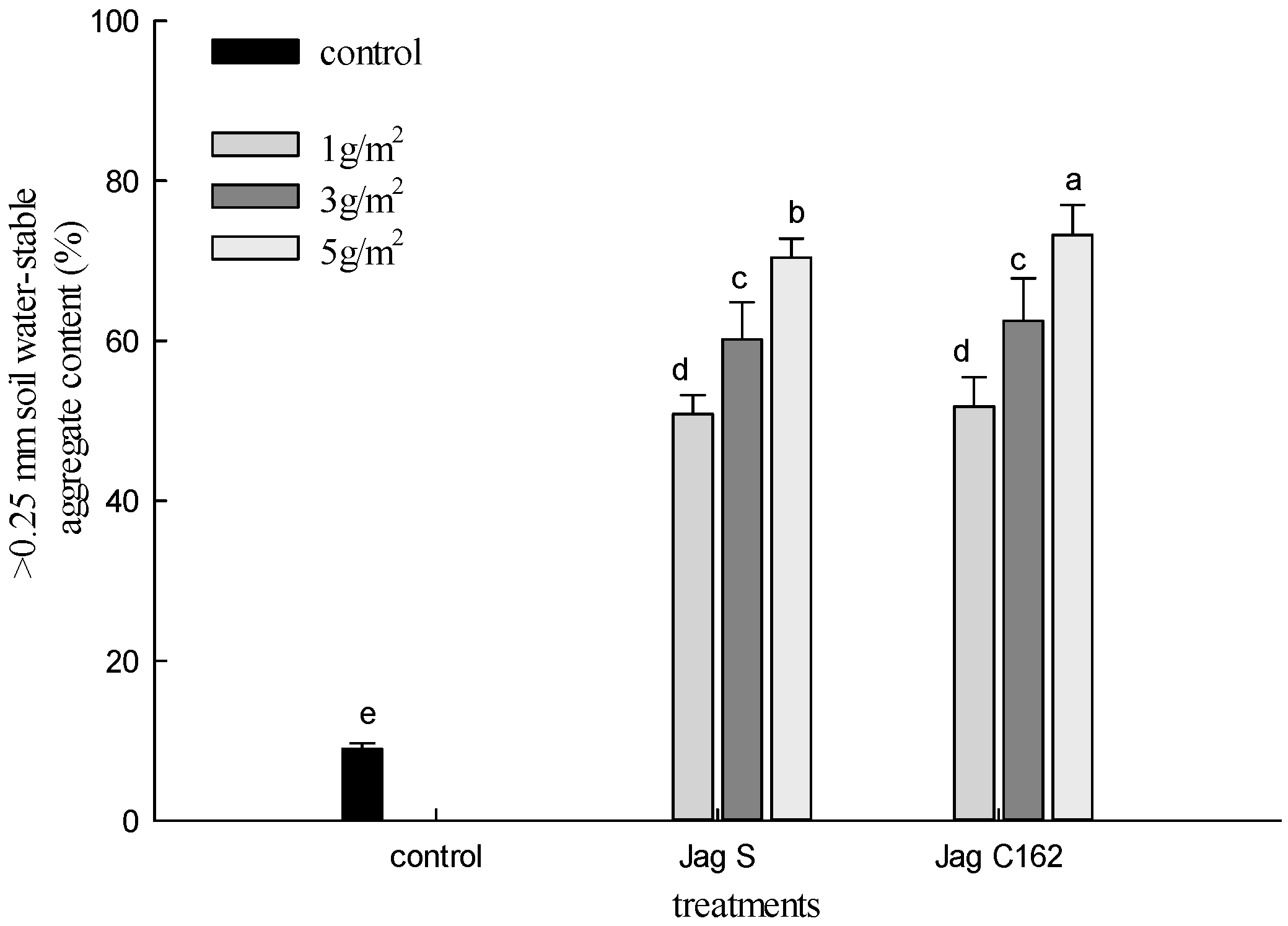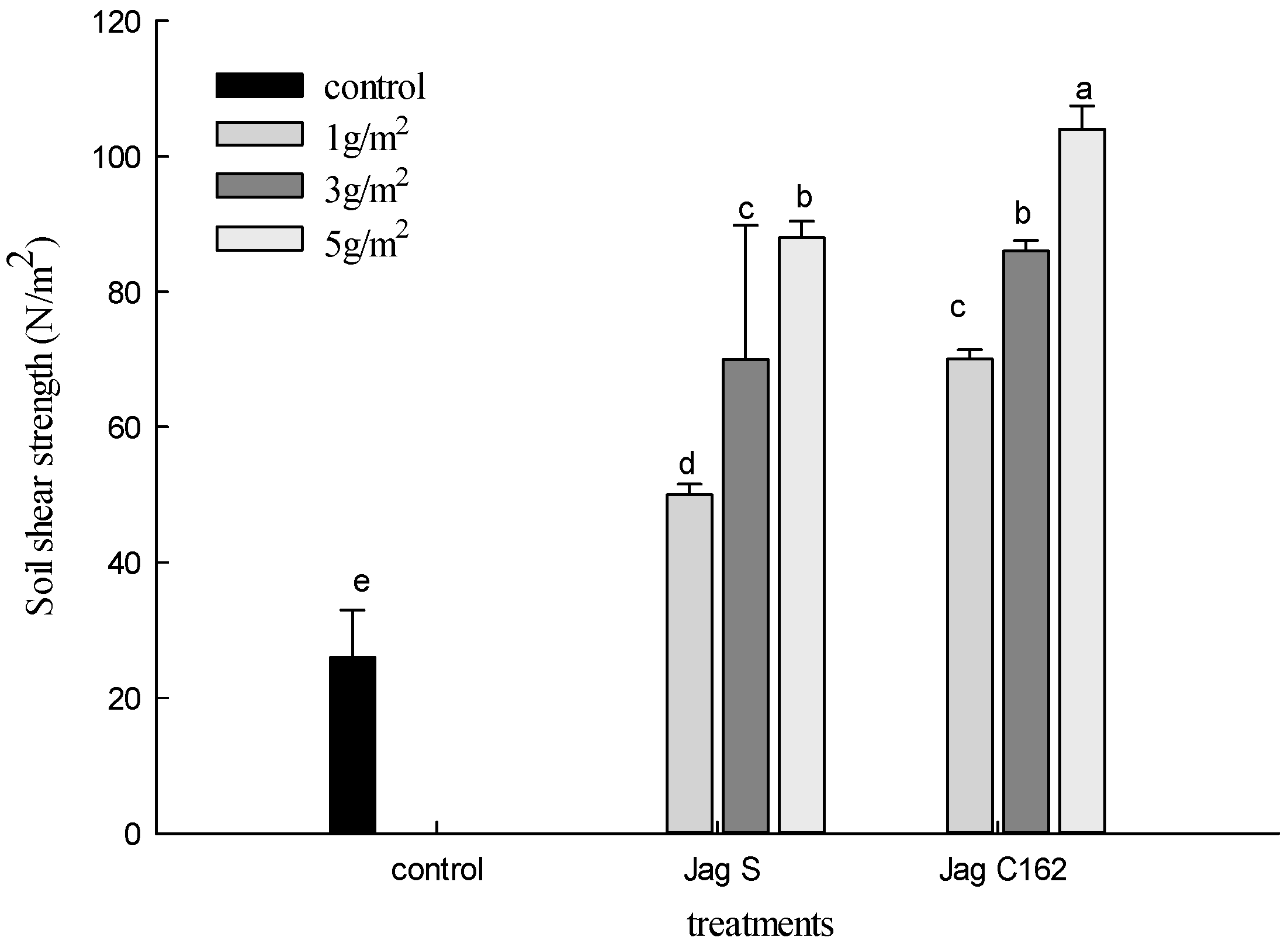Efficacy of Natural Polymer Derivatives on Soil Physical Properties and Erosion on an Experimental Loess Hillslope
Abstract
:1. Introduction
2. Materials and Methods
2.1. Soil and Polymers
2.2. Experiments
2.3. Measurements
3. Results
3.1. Effects of Jag S and Jag C162 on Soil Physical Properties
3.1.1. Effects on >0.25 mm Water-Stable Aggregates
3.1.2. Effects on Shear Strength
3.2. Effects on Soil Erosion Process
3.2.1. Effects on Rainfall Infiltration
3.2.2. Effects on Sediment
4. Discussion
5. Conclusions
Acknowledgments
Author Contributions
Conflicts of Interest
References
- Agassi, M.; Shainberg, I.; Morin, J. Effect of electrolyte concentration and soil sodicity on the infiltration rate and crust formation. Soil Sci. Soc. Am. J. 1981, 45, 848–851. [Google Scholar] [CrossRef]
- Ben-Hur, M.; Shainberg, I.; Baker, D.; Keren, R. Effects of soil texture and CaCO3 content on water infiltration in crusted soil as related to water salinity. Irrig. Sci. 1985, 6, 281–294. [Google Scholar] [CrossRef]
- Wakindiki, I.I.C.; Ben-Hur, M. Soil mineralogy and texture effects on crust micromorphology, infiltration, and erosion. Soil Sci. Soc. Am. J. 2002, 66, 897–905. [Google Scholar] [CrossRef]
- Roberts, K.; Kowalewska, J.; Friberg, S. The influence of interactions between hydrolyzed aluminum ions and polyacrylamides on the sedimentation of kaolin suspensions. J. Colloid Interfaces Sci. 1974, 48, 361–367. [Google Scholar] [CrossRef]
- Santos, F.L.; Reis, J.L.; Martins, O.C.; Castanheira, N.L.; Serralheiro, R.P. Comparative assessment of infiltration, runoff and erosion of sprinkler irrigated soils. Biosyst. Eng. 2003, 86, 355–364. [Google Scholar] [CrossRef]
- Botha, F.J.; Burer, R.; Du, T. Liquid-solid contacts of fine sandy soils by polyvinyl alcohol. Tech. Commun. Dept. Agric. Fish 1980, 174, 56–58. [Google Scholar]
- Pini, R.; Vigna, S. Soil microaggregation as influenced by unchanged organic conditioner. Commun. Oil Sci. Plant Anal. 1994, 25, 2215–2229. [Google Scholar] [CrossRef]
- Floyd, C.N. A mobile rainfall simulator for small plot field experiments. J. Agric. Eng. Res. 1980, 26, 307–314. [Google Scholar] [CrossRef]
- Liu, J.; Shi, B.; Gu, K.; Jiang, H.T.; Inyang, H.I. Effect of polyurethane on the stability of sand–clay mixtures. Bull. Eng. Geol. Environ. 2012, 71, 537–544. [Google Scholar] [CrossRef]
- Green, V.S.; Stott, D.E.; Norton, L.D.; Graveel, J.G. PAM molecular weight and charge effects on infiltration under simulated rainfall. Soil Sci. Soc. Am. J. 2000, 64, 1786–1791. [Google Scholar] [CrossRef]
- Sojka, R.E.; Surapaneni, A. Potential Use of Polyacrylamide (PAM) in Australian Agriculture to Improve off and on-Site Environmental Impacts and Infiltration Management; Land and Water Resources Research and Development Corporation: Canberra, Australia, 2000. [Google Scholar]
- Shainberg, I.; Levy, G.J. Organic polymers and soil sealing in cultivated soil. Soil Sci. 1994, 158, 267–273. [Google Scholar] [CrossRef]
- Vacher, C.A.; Loch, R.J.; Raine, S.R. Effect of polyacrylamide additions on infiltration and erosion of disturbed lands. Aust. J. Soil Res. 2003, 41, 1509–1520. [Google Scholar] [CrossRef] [Green Version]
- Yu, J.; Lei, T.; Shainberg, I.; Mamedov, A.I.; Levy, G.J. Infiltration and erosion in soils treated with dry PAM and gypsum. Soil Sci. Soc. Am. J. 2003, 67, 630–636. [Google Scholar] [CrossRef]
- Wang, A.; Li, F.; Yang, S. Effect of polyacrylamide application on runoff, erosion, and soil nutrient loss under simulated rainfall. Pedosphere 2011, 21, 628–638. [Google Scholar] [CrossRef]
- Tang, Z.J.; Lei, T.W.; Zhang, Q.W.; Zhao, J. Effects of polyacrylamides application on infiltration and soil erosion under simulated rainfalls I: Infiltration. Acta Pedol. Sin. 2003, 40, 178–185. (In Chinese) [Google Scholar]
- Wu, S.F.; Wu, P.T.; Feng, H.; Bu, C.F. Influence of amendments on soil structure and soil loss under simulated rainfall China’s loess plateau. Afr. J. Biotechnol. 2010, 9, 6116–6121. [Google Scholar]
- Liu, J.E.; Wang, Z.L.; Yang, X.M.; Jiao, N.; Shen, N.; Ji, P.F. The impact of natural polymer derivatives on sheet erosion on experimental loess hillslope. Soil Till. Res. 2014, 139, 23–27. [Google Scholar] [CrossRef]
- Yoder, R.E. A direct method of aggregate analysis of soils and a study of the physical nature of erosion losses. J. Am. Soc. Agron. 1936, 28, 337–351. [Google Scholar] [CrossRef]
- Ma, F.; Zhang, P.H.; Wang, J.; Zheng, T.H.; Zhang, Q.W. Comparison of rapid methods for soil water content. J. Anhui Agric. Sci. 2014, 42, 6591–6593, 6607. (In Chinese) [Google Scholar]
- Coote, D.R.; Malcolm, C.A.; Wall, G.J.; Dickinson, W.T.; Rudra, R.P. Seasonal variation of erodibility indices based on shear strength and aggregate stability in some Ontaril soils. Can. J. Soil Sci. 1988, 68, 405–416. [Google Scholar] [CrossRef]
- Ohu, J.O. Peatmoss Influence on Strength, Hydraulic Characteristics and Crop Production of Compacted Soils. Ph.D. Thesis, McGill University, Montreal, QC, Canada, 1985. [Google Scholar]
- Green, V.S.; Stott, D.E.; Graveel, J.G.; Norton, L.D. Stability analysis of soil aggregates treated with anionic polyacrylamides of different molecular formulations. Soil Sci. 2004, 169, 573–581. [Google Scholar] [CrossRef]
- An, H.P. Study on soil anti-erodibility and predicting model in the middle reaches of North Panjiang River. J. Soil Water Conserv. 2000, 14, 38–42. (In Chinese) [Google Scholar]
- Aly, S.M.; Letey, J. Polymer and water quality effects on flocculation of montmorillionite. Soil Sci. Soc. Am. J. 1988, 52, 1453–1458. [Google Scholar] [CrossRef]
- Ben-Hur, M.; Letey, J. Effect of polysaccharides, clay dispersion and impact energy on water infiltration. Soil Sci. Soc. Am. J. 1989, 53, 233–238. [Google Scholar] [CrossRef]
- Ben-Hur, M. Runoff, erosion and polymer application in moving-sprinkler irrigation. Soil Sci. 1994, 158, 283–290. [Google Scholar] [CrossRef]
- Xu, S.T.; Zhang, L.; McLaughlin, N.B.; Mi, J.Z.; Chen, Q.; Liu, J.H. Effect of synthetic and natural water absorbing soil amendment soil physical properties under potato production in a semi-arid region. Soil Till. Res. 2015, 148, 31–39. [Google Scholar] [CrossRef]
- Zhang, X.C.; Miller, W.P. Polyacrylamide effect on infiltration and erosion in furrows. Soil Sci. Soc. Am. J. 1996, 60, 866–872. [Google Scholar] [CrossRef]
- Al-Durrah, M.; Bradford, J.M. New methods of studying soil detachment due to waterdrop impact. Soil Sci. Soc. Am. J. 1981, 45, 949–953. [Google Scholar] [CrossRef]
- Lentz, R.D.; Sojka, R.E. Field results using polyacrylamide to manage furrow erosion and infiltration. Soil Sci. 1994, 158, 274–282. [Google Scholar] [CrossRef]
- Bjorneberg, D.L.; Aase, J.K. Multiple polyacrylamide applications for controlling sprinkler irrigation runoff and erosion. Appl. Eng. Agric. 2000, 16, 501–504. [Google Scholar] [CrossRef]
- Sepaskhah, A.R.; Bazrafshan-Jahromi, A.R. Controlling runoff and erosion in sloping land with polyacrylamide under a rainfall simulator. Biosyst. Eng. 2006, 93, 469–474. [Google Scholar] [CrossRef]
- Mamedov, A.I.; Wagner, A.E.; Huang, C.; Norton, L.D.; Levy, G.J. Polyacrylamide effects on aggregate and structure stability of soils with different clay mineralogy. Soil Sci. Soc. Am. J. 2010, 74, 1720–1732. [Google Scholar] [CrossRef]
- Schamp, N.; Huylebroeck, J.; Sadones, M. Ahhesion and adsorption phenomena in soil conditions. In Proceedings of the Sumposium on Experimental Methods and Users of Soil Conditioners, Madison, WI, USA, January 1975; pp. 13–23. [Google Scholar]






| Sizes | Contents of Different Sizes of Soil Aggregates (%) | Percentage Increase of the Content of Different Sizes of Soil Aggregates (%) | |||||||||||
|---|---|---|---|---|---|---|---|---|---|---|---|---|---|
| Control | Jag S Rates | Jag C162 Rates | Jag S Rates | Jag C162 Rates | |||||||||
| (mm) | 1 g/m2 | 3 g/m2 | 5 g/m2 | 1 g/m2 | 3 g/m2 | 5 g/m2 | 1 g/m2 | 3 g/m2 | 5 g/m2 | 1 g/m2 | 3 g/m2 | 5 g/m2 | |
| >5 | 0 e | 0.26 de | 0.52 de | 1.74 c | 0.88 d | 3.43 b | 5.92 a | 0.26 | 0.52 | 1.74 | 0.88 | 3.43 | 5.92 |
| 2–5 | 1.06 d | 3.72 cd | 6.75 c | 22.4 ab | 10.8 c | 20.2 b | 25.9 a | 2.66 | 5.69 | 21.3 | 9.70 | 19.1 | 24.9 |
| 1–2 | 1.86 d | 12.0 c | 16.1 ab | 19.1 a | 14.7 bc | 16.3 ab | 17.5 ab | 10.1 | 14.2 | 17.2 | 12.9 | 14.4 | 15.7 |
| 0.5–1 | 2.47 c | 14.1 ab | 16.2 a | 13.2 ab | 11.4 b | 10.4 b | 10.0 b | 11.6 | 13.7 | 10.7 | 8.96 | 7.93 | 7.55 |
| 0.25–0.5 | 3.58 c | 21.4 a | 20.1 a | 14.0 b | 14.3 b | 11.6 b | 13.8 b | 17.8 | 17.0 | 10.4 | 10.7 | 7.98 | 10.2 |
| <0.25 | 91.0 a | 49.2 b | 39.8 c | 29.6 d | 48.2 b | 37.5 c | 26.8 e | −41.9 | −51.2 | −61.4 | −42.8 | −53.5 | −64.3 |
| Control | Jag S Rates | Jag C162 Rates | |||||
|---|---|---|---|---|---|---|---|
| 1 g/m2 | 3 g/m2 | 5 g/m2 | 1 g/m2 | 3 g/m2 | 5 g/m2 | ||
| Shear strength (N/m2) | 26.0 e | 50.0 d | 70.0 c | 88.0 b | 70.0 c | 86.0 b | 104.0 a |
| Percentage increase (%) | 92.9 | 171.5 | 241.7 | 173.3 | 232.9 | 305.4 | |
| The Final IR under Different Rainfall Intensities (mm/min) | |||||||
|---|---|---|---|---|---|---|---|
| Rainfall Intensity (mm/min) | Control | Jag S Rates | Jag C162 Rates | ||||
| 1 g/m2 | 3 g/m2 | 5 g/m2 | 1 g/m2 | 3 g/m2 | 5 g/m2 | ||
| 1.0 | 0.65 c | 0.81 ab | 0.78 ab | 0.72 bc | 0.85 a | 0.86 a | 0.87 a |
| 1.5 | 0.73 c | 1.06 ab | 0.86 bc | 0.70 c | 1.04 a | 1.08 a | 1.14 a |
| 2.0 | 0.59 b | 1.27 ab | 0.85 ab | 0.64 ab | 1.03 ab | 1.31 ab | 1.51 a |
| Reductions of Cumulative Erosion Modulus (%) | |||||||
|---|---|---|---|---|---|---|---|
| Rainfall Intensity (mm/min) | Control (kg/m2) | Jag S Rates | Jag C162 Rates | ||||
| 1 g/m2 | 3 g/m2 | 5 g/m2 | 1 g/m2 | 3 g/m2 | 5 g/m2 | ||
| 1.0 | 0.14 c | 19.1 c | 35.1 bc | 48.4 b | 27.5 bc | 56.7 ab | 63.3 ab |
| 1.5 | 0.33 b | 30.5 ab | 56.9 a | 66.9 a | 30.5 ab | 56.9 ab | 66.9 a |
| 2.0 | 0.50 c | 20.5 b | 54.7 a | 64.3 a | 20.5 b | 55.7 a | 69.2 a |
© 2017 by the authors. Licensee MDPI, Basel, Switzerland. This article is an open access article distributed under the terms and conditions of the Creative Commons Attribution (CC BY) license (http://creativecommons.org/licenses/by/4.0/).
Share and Cite
Liu, J.; Wang, Z.; Li, Y. Efficacy of Natural Polymer Derivatives on Soil Physical Properties and Erosion on an Experimental Loess Hillslope. Int. J. Environ. Res. Public Health 2018, 15, 9. https://doi.org/10.3390/ijerph15010009
Liu J, Wang Z, Li Y. Efficacy of Natural Polymer Derivatives on Soil Physical Properties and Erosion on an Experimental Loess Hillslope. International Journal of Environmental Research and Public Health. 2018; 15(1):9. https://doi.org/10.3390/ijerph15010009
Chicago/Turabian StyleLiu, Jun’e, Zhanli Wang, and Yuanyuan Li. 2018. "Efficacy of Natural Polymer Derivatives on Soil Physical Properties and Erosion on an Experimental Loess Hillslope" International Journal of Environmental Research and Public Health 15, no. 1: 9. https://doi.org/10.3390/ijerph15010009




